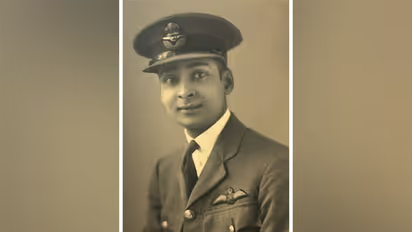From the IAF Vault: Story of the first officer to fly IAF aircraft

Synopsis
Harish Chander Sircar was the first and senior-most officer commissioned in the IAF on 8 October 1932. More dubiously, he also holds the record for the first to be dismissed from service in March 1935. IAF historian Anchit Gupta narrates the story of the officer, who had several firsts to his name
Harish Sircar hailed from a cultured and aristocratic Bengali family. Imbued with a passion for flying from an early age, he joined the IAF with alacrity when the opportunity arose. Intelligent with an athletic frame, he made a tremendous impression on his colleagues.
In September 1930, he was chosen to be amongst the first six to be trained as pilots at the RAF College Cranwell in Lincolnshire, UK. The training included flying on aircraft like the Avro Lynx, Armstrong Whitworth Atlas and AW Siskin. Between the flying and classroom training, Sircar took to sports and was the Hockey team captain.
He had flown about 130 hours by July 1932 and graduated from Cranwell with four Indians. He was the best and was placed first, receiving his commission. With the IAF yet to be formed, he proceeded to the Army co-operation course for the next few months.
At the end of the course, he was placed fifth; the four above him being British officers. He, along with the other Indians, was then posted to 16 Squadron of the Royal Air Force, to fly with the unit and be ready to move to India. A move that transpired in early March 1933.
The Number 1 Squadron of the IAF thrived despite much British resistance due to the support of its Commanding Officer, Boy Bouchier. Sircar earned two more firsts in May 1933 -- the first to fly an IAF aircraft and the first to go solo on an IAF aircraft.
Sircar was considered so good that soon he was part of the IAF formation flight with Bouchier and the Flight Commander Peter Broad, as the other members. When the King’s birthday came, he was the only Indian to participate in the flypast -- the first Indian again!
Over the next year, the only IAF flight was put through its paces. Sircar was Bouchier’s favourite. Within a few months, he was doing photography, front attacks, bombing, puff shots, close recce, and cooperation exercises with the Baluch apart from formation flying.
Bouchier, though, was a lone man standing in support of the IAF. Scepticism among the Britishers was rife about whether the IAF would be a still-born experiment. He faced several challenges -- two of the first five pilots had crashed and died, and airmen had resorted to mutiny due to poor wages.
Life was going to be harder for him. On a dearly and cold winter morning of 8 January 1935, a Wapiti, piloted by Sircar crashed into 4/10 Baluch Troops, killing more than 15 of them. Sircar and Gunner Abdul Salaam survived with injuries. The IAF’s survival was at risk.
On that day, three Wapiti’s had taken off. Bouchier had given up the idea of formation due to strong winds. The mission was to carry out low attacks on a battalion, the 4/10th Baluch Regiment. An hour later, Bouchier landed with news -- 'Sircar has crashed on top of the Troops'.
It transpired that Sircar came downwind and was caught in the slipstream of Bouchier and Philip. He tried to pull up but to no use. The aircraft caught fire and was burnt. Sircar was court-martialed and dismissed, though his sentence of rigorous imprisonment was squashed.
Many tried to help Sircar. Chief Technical Officer, Squadron Leader Norton argued with the court on the effects of wind currents on aerofoils. He believed that a strong gale had caused a loss of lift to the aerofoil when downwind. The stick could not pull the aeroplane out of a partial stall.
Bouchier was so disappointed that he did not speak to the boys for a month. He kept thinking more could have been done to save Sircar. Awan and Mukerjee bid a tearful farewell to Sircar, now the only two remaining pilots from the initial five.
Sircar seems to have joined civil aviation later. He died in 1977. In 2019, Sircar’s son met this author and handed over his logbooks, which were subsequently given to the IAF museum. Sircar’s career promised a lot but met a tragic end, much to the loss of the IAF and India.
Stay updated with the Breaking News Today and Latest News from across India and around the world. Get real-time updates, in-depth analysis, and comprehensive coverage of India News, World News, Indian Defence News, Kerala News, and Karnataka News. From politics to current affairs, follow every major story as it unfolds. Download the Asianet News Official App to stay informed anytime, anywhere.